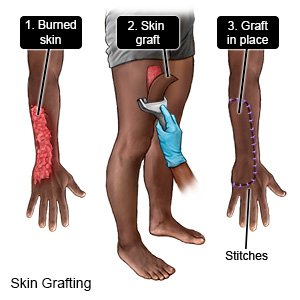Skin Grafting
Medically reviewed by Drugs.com. Last updated on Aug 4, 2025.
Skin grafting is surgery to cover and repair wounds with a skin graft. A skin graft is healthy skin taken from an area of your body called the donor site. The skin may be taken from an area near the injury to match the area where the graft will be placed. Grafts that are artificial or come from another person or animal may be used temporarily. These are used as covers when large areas of the skin are damaged. They are replaced with your own skin over time.
 |
DISCHARGE INSTRUCTIONS:
Call your local emergency number (911 in the US) if:
- You have sudden trouble breathing.
Seek care immediately if:
- Blood soaks through your bandage.
- You feel something is bulging out from your graft site and not going back in.
- Your graft or donor site has blood, pus, or a foul-smelling odor.
- You have more pain in the graft area.
Call your doctor or surgeon if:
- You have a fever.
- You have nausea or are vomiting.
- Your skin is itchy, swollen, or has a rash.
- You have questions or concerns about your condition or care.
Related medications
Medicines:
Do not take any medicine that has aspirin or blood thinners in it. These medicines may make you more likely to bleed. You may need any of the following:
- Prescription pain medicine may be given. Ask your healthcare provider how to take this medicine safely. Some prescription pain medicines contain acetaminophen. Do not take other medicines that contain acetaminophen without talking to your healthcare provider. Too much acetaminophen may cause liver damage. Prescription pain medicine may cause constipation. Ask your healthcare provider how to prevent or treat constipation.
- Antibiotics help prevent or fight an infection caused by bacteria.
- Anti-itching medicine may be needed.
- Take your medicine as directed. Contact your healthcare provider if you think your medicine is not helping or if you have side effects. Tell your provider if you are allergic to any medicine. Keep a list of the medicines, vitamins, and herbs you take. Include the amounts, and when and why you take them. Bring the list or the pill bottles to follow-up visits. Carry your medicine list with you in case of an emergency.
Rest when you feel it is needed.
Slowly start to do more each day. Return to your daily activities as directed.
Care for the skin grafting area:
- Keep the area clean and dry. When your surgeon says it is okay to bathe, carefully wash the graft and donor sites with soap and water. Dry the area and put on clean, new bandages as directed. Change your bandages every time they get wet or dirty.
- Elevate your arm or leg if you have a graft or donor site there. Prop your arm or leg on pillows to raise the area above your heart as often as you can. This will help decrease swelling.
- Limit movements, such as stretching. This will help prevent bleeding, shearing, and swelling in the wound and graft sites.
- Prevent scarring and skin color changes. Do not rub or scratch the donor and graft sites. Protect the graft site from direct sunlight for at least 6 months.
Follow up with your doctor or surgeon as directed:
You will need to follow up to have your stitches removed, bandages changed, and wounds checked. Any fluid that has collected in the graft site will be removed. Write down your questions so you remember to ask them during your visits.
© Copyright Merative 2025 Information is for End User's use only and may not be sold, redistributed or otherwise used for commercial purposes.
The above information is an educational aid only. It is not intended as medical advice for individual conditions or treatments. Talk to your doctor, nurse or pharmacist before following any medical regimen to see if it is safe and effective for you.
Further information
Always consult your healthcare provider to ensure the information displayed on this page applies to your personal circumstances.
